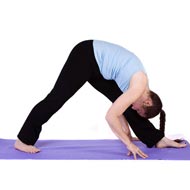Forward bend Poses
Like back bends, forward bend yoga poses target a specific part of the human anatomy. Back bends strengthen and stretch the front - the shoulders, the thighs, the abdomen and the chest.
Forward bend poses perform the same function on the buttocks, the back, the hamstrings and the calves.
Forward bend poses are executed by bending forward, using your midsection as a hinge and getting your chest as close to your thighs as possible. Hence the back is opened up and elongated. Another function that back bends perform is to tone and strengthen the organs in the abdominal cavity. By systematically compressing and decompressing the abdomen, the digestive organs get massaged. Forward bend poses also improve the circulation in the body.
As humans we also have a history with this posture. In the womb, babies are born while resting in the fetal position. It takes a newborn baby a couple of months just for them to have enough strength to stay upright. The arched back straightens a lot later.
According to yogic principle, the act of folding oneself signifies a oneness with your own consciousness. It also helps a person to have a period of introspection. The yoga pose in itself allows every other outside distraction to be muted.
When first embarking on forward bend poses, our bodies may not be ready for it because our spinal muscles may not have developed enough. Hence beginners are advised to work on first strengthening the back muscles by performing the simpler forward bend yoga poses.
One aspect to remember is that you should always keep your breathing even, and synchronize the inhalations and exhalations with contractions and relaxations of the pose.
Here is a list of yoga poses that incorporate forward bends:
- The "Downward Facing Dog" Pose (Adho Mukha Svanasana) – This is an excellent yoga beginner asana. In Order for this pose to be effective, try to maintain the posture for about 1 to 3 minutes
- The "Dolphin" Pose – This pose focuses on stretching out the upper back.
You mustn’t attempt this pose if you have suffered from shoulder or neck injuries. - The “Hand to Foot” Pose (Padahastasana) – This pose is a variation of the Standing Forward Bend. Like all the other forward bend poses, this pose improves flexibility, strengthens your legs, aids in digestion and improves circulation.
- The "Warrior" Pose III (Virabhadrasana III) – This pose concentrates on improving balance and stability. This is a variation of the Warrior pose. The first two variations concentrate on stretching out the thighs and the hamstrings.
- The "Extended Hand-To-Big-Toe" Pose (Utthita Hasta Padangustasana) – A tip for carrying out this pose is to use a chair to prop up the extended leg. Although this pose doesn’t involve getting your chest right down to your thighs, it does involve a variation of a forward bend.
- The "Staff" Pose (Dandasana) – If you have a problem with your posture, this pose can help you improve it. A tip for amateurs is to imagine the length of your spine as a "staff" planted firmly into the ground, anchoring and proving support to every action you carry out.
- The "Bound Angle" Pose (Baddha Konasana) – This pose is an example of a seated forward bend. Perform this pose with a mat or a blanket spread out under your thighs.
- The "Head-to-Knee" Pose (Janushirasana) – This is one of the more advanced forward bend- incorporating yoga poses. As a build up to this pose you can start with the "Downward Facing Dog", "The Bound Angle Pose", and the "Child’s Resting Pose"
- The "Wide Angle Seated Forward Bend" Pose (Upavistha Konasana) – The Upavistha Konasana is a difficult pose for beginners to perform. A tip would be to bend your knees instead of having them rigid and straight. But remember to keep the kneecaps pointed towards the ceiling at all times.



